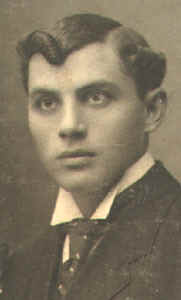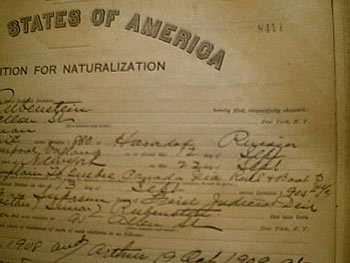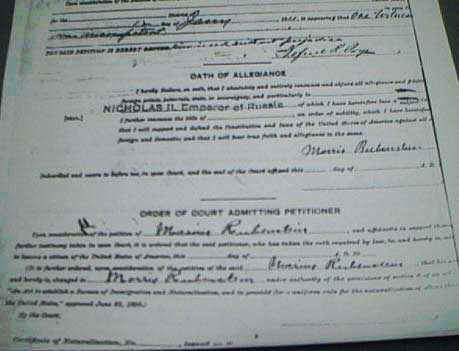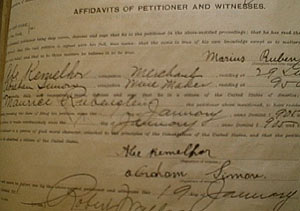Abe Kemelhor, a merchant, and Herman Nemetzky, also a
merchant, "each being severally, duly, and respectively sworn" and deposed,
first claimed themselves to be "a citizen of the United States of America;" and
next, to have "personally known" Marius for five years. It was later revealed
that Herman Nemetzky was not a citizen.Petition denied
Entries made over six months later show that Marius' Petition for Naturalization was
not successful. On January 12, 1911, the section entitled "Order of Court Denying
Petition" on the back was filled in as follows: "…it appearing that one
witness was incompetent, the said petition is hereby dismissed without prejudice."
So, while the card catalog entry says, "denied," the actual petition actually
said "dismissed without prejudice." Morris went on to make good use of the day.
Marius becomes Morris
Below the section denying his petition for citizenship is the section for change of
name. It reads, "…upon consideration of the petition of the said Marius
Rubenstein, that his name…hereby is changed to Morris Rubenstein, under authority of
the provisions of [an act that went into effect in 1906]." It is touching that
perhaps the first time Morris wrote his newly restored name, it was to sign the Oath of
Allegiance, and on the very day he was denied citizenship.
Morris 'renounces' Nicholas II, Emperor of Russia
The same section of the petition provides space for taking the Oath of Allegiance, and
so, having just lost 'Marius' and regained Morris, he took this opportunity to take care
of that. "…I absolutely and entirely renounce and abjure all allegiance and
fidelity to any foreign price, potentate, state, or sovereignty, and particularly to
Nicholas II, Emperor of Russia, of [whom] I have heretofore been a subject…"
Morris tries again
Just seven days after the date of his denied petition, Morris tried again. On January
19, 1911, he signed his second petition for naturalization, again using Marius, no doubt
because that was the name used on his Declaration of Intention to become a citizen. As for
witnesses, merchant Abe Kemelhor came again, and the second witness was Morris'
father-in-law, Abraham Simon, who listed his occupation as "wine maker." (In the
New York City directory of 1910, he had listed his occupation as "juice.")
Abraham would have been 51 years old on witnessing for his son-in-law, who was then 31
years old. Morris' second petition is our only known sample of the signature of Abraham
Simon.
'Mauris' [sic] gains citizenship
Nine days short of six months after his second petition for naturalization, Morris was
successful. First he had to repledge his allegiance, and he had to do so as Marius, that
having been the name used both on his intention and his second petition. In the
"Order of Court Admitting Petitioner," it is written that "Mauris [sic]
Rubenstein" is "admitted to become a citizen.…" Mauris was issued
Certificate of Naturalization No. 214889, on July 10, 1911.






